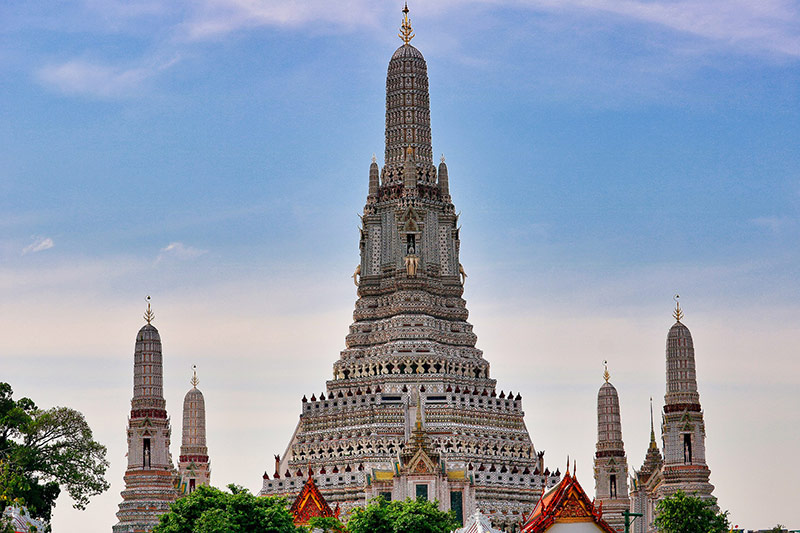With its stunning design, rich history, and peaceful atmosphere, Wat Arun is a true testament to the beauty and creativity of Thai culture. Also known as the Temple of Dawn, it is located on the west bank of the Chao Phraya River in Bangkok, Thailand. Named after Aruna, the Hindu God of Dawn, it is one of the most iconic landmarks of Bangkok and attracts millions of visitors every year.

Are you ready to be dazzled? Here is a comprehensive guide to the spectacular Wat Arun, that’ll give you all the information you need.
Discover the beauty of Thailand with Indo Thai News– your one-stop-shop for the latest update on India & Thailand travel & culture news
History of Wat Arun
In the 17th century during the Ayutthaya period, people originally built the temple and called it Wat Makok. Later, King Taksin renovated it in the late 18th century and renamed it Wat Chaeng. The current name, Wat Arun, was given by King Rama II in the early 19th century.

The temple’s towering Khmer-style prang (tower) covered in colourful glass and Chinese porcelain is a unique architectural wonder. It is believed to symbolize Mount Meru, which is considered the center of the universe in Hindu-Buddhist cosmology.
Architecture and Design
The stunning Khmer-style architecture of Wat Arun, which features intricate designs and exquisite details, is well-known. The temple’s most iconic feature is the central tower, which stands over 70 meters tall and decorated with millions of pieces of Chinese porcelain and seashells. The tower is surrounded by four smaller towers, each representing the four elements of earth, water, fire, and wind.

The temple is also home to several other stunning features, including a courtyard filled with statues of mythical creatures and intricate carvings, a Buddha image, and a beautiful pavilion decorated with colourful murals.
How to Get There
Wat Arun is located on the west bank of the Chao Phraya River, opposite Wat Pho and the Grand Palace.
The easiest way to get there is by taking a river taxi or tourist boat from the Sathorn or Central Pier. You can take a BTS from anywhere to Saphan Taksin and take a boat ride to Wat Arun. Alternatively, you can take a taxi or tuk-tuk to Tha Tien Pier, a short walk from the temple.
Check out our Wat Arun Vlog where Indo Thai Correspondent Sanjana Timsinha takes you on a virtual tour of Wat Arun
Opening Hours and Admission Fees
Wat Arun is open daily from 8 am to 6 pm. The admission fee is 100 baht for adults and free for children under 120 cm in height.
Things to See and Do in Wat Arun
The towering Khmer-style prang, covered in colourful glass and Chinese porcelain, is the most impressive feature of Wat Arun.
Visitors can climb up the steep stairs to the top of the prang. It offers a stunning view of the Chao Phraya River and the surrounding area. However, you should know that the stairs are quite steep and narrow and may not be suitable for those with mobility issues.

Other highlights of Wat Arun include the beautifully decorated Ordination Hall, the impressive murals depicting scenes from the Ramakien (the Thai version of the Ramayana), and the Buddha statue in the middle of the temple complex.
Liked this post? Pin it for Later

Tips for Visitors
- Dress modestly and remove your shoes before entering the temple grounds.
- It gets quite hot during the day, so bring a hat and sunscreen to protect yourself from the sun.
- It is especially beat sunrise and sunset when the sunlight reflects off the glass and porcelain tiles on the prang.
- The views from the top of the prang are truly spectacular, so bring a camera or smartphone to capture the moment.
Wat Arun is a must-visit destination for anyone travelling to Bangkok. Its stunning architecture, beautiful decorations, and rich history make it a unique and memorable experience you will never forget.
Follow Indo Thai News for the latest lifestyle news.
Four more must-read articles from Indo Thai News
Veggie Pad Thai: A Mouth-watering Twist on a Classic Dish
Koh Lipe: Explore this Paradise in Thailand



